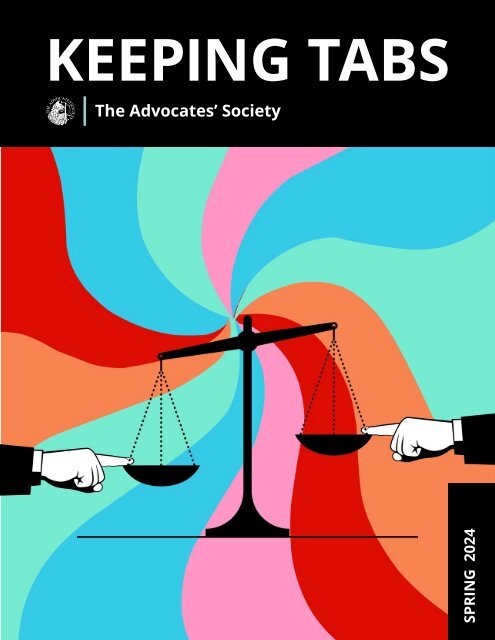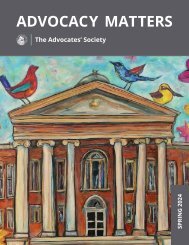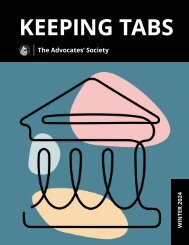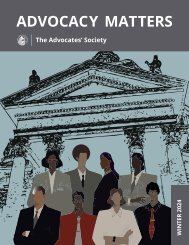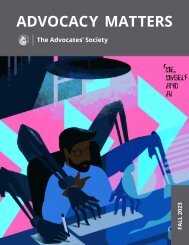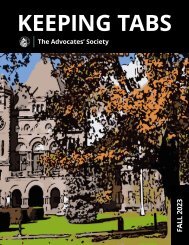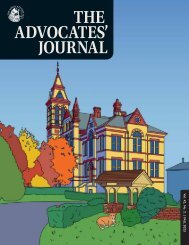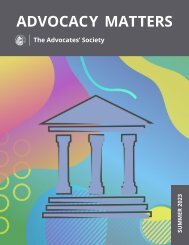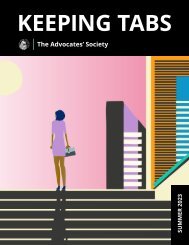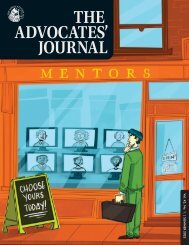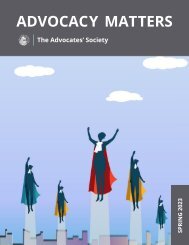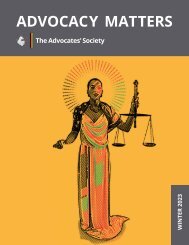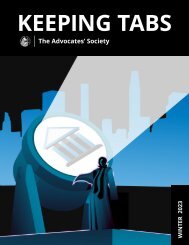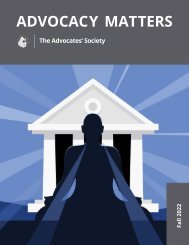Keeping-Tabs-Spring-2024
Stay up-to-date on news and events from our Young Advocates' Standing Committee (YASC) with Keeping Tabs.
Stay up-to-date on news and events from our Young Advocates' Standing Committee (YASC) with Keeping Tabs.
You also want an ePaper? Increase the reach of your titles
YUMPU automatically turns print PDFs into web optimized ePapers that Google loves.
KEEPING TABS<br />
The Advocates’ Society<br />
SPRING <strong>2024</strong>
CONTENTS<br />
05<br />
08<br />
10<br />
13<br />
17<br />
22<br />
24<br />
Chair Chat<br />
Chris Kinnear Hunter (he/him), Torys LLP<br />
A Cheat Sheet for Commercial Litigators: Key<br />
Procedural Differences Between Lien Actions and<br />
Other Actions<br />
Cassie Chaloux (she/her), WeirFoulds LLP<br />
In Favour of Efficiency: A Comment on Conditional<br />
Certification in Class Action Proceedings and<br />
Vecchio Longo Consulting Services Inc. v Aphria Inc.,<br />
2021 ONSC 5405<br />
Tom Russell (he/him), Stieber Berlach LLP<br />
Arnup Cup Report<br />
Tomislav Miloš (he/him), MMW LLP<br />
Practice Pitfall: Avoiding a “Handley” Stay Motion<br />
Robert Stellick (he/him), Adair Goldblatt Bieber LLP<br />
Judgment and Restraint: Litigating Against the<br />
Self-Represented<br />
Sarah E. Naughton (she/her), Cunningham, Swan, Carty, Little &<br />
Bonham LLP<br />
Interview with Abdalla Barqawi (he/him), Conway<br />
Baxter Wilson LLP/s.r.l.<br />
Compiled by Ali Háji (he/him), Ricketts Harris LLP<br />
More information is available on the<br />
TAS mentoring website page.<br />
TAS Junior Members are automatically<br />
signed up. Click here to set up your<br />
profile today!<br />
Editor: Eric Blay (he/him), Stikeman Elliott | eblay@stikeman.com<br />
Deputy Editor: Julie Mouris (she/her), Conway Baxter Wilson LLP/s.r.l. |<br />
jmouris@conwaylitigation.ca<br />
<strong>Keeping</strong> <strong>Tabs</strong> Editorial Team: Katrina Crocker, Henein Hutchison Robitaille LLP, Lisa Delaney (she/her), Cox & Palmer, Aly Háji (he/him), Rickets Harris LLP, Glynnis<br />
Hawe, Paliare Roland Rosenberg Rothstein LLP, Karlson Leung (he/him), Ministry of the Attorney General, Crown Law Office and Jean-Simon Schoenholz, Norton Rose Fulbright LLP<br />
2<br />
2 3<br />
Want to mentor? Opt-in to be a mentor<br />
on your TAS member profile.<br />
The Young Advocates’ Standing Committee (“YASC”) is a standing committee of The Advocates’ Society with a mandate to be a voice for young advocates (advocates<br />
who are ten years of call or fewer) within the Society and within the profession. We do this through networking/mentoring events, by publishing articles by and<br />
for young advocates, and by raising issues of concern to young advocates as we work with the Society’s Board of Directors. The opinions expressed by individual<br />
authors are their own and do not necessarily reflect the policies of The Advocates’ Society.
WHAT’S COMING UP @ TAS<br />
(Click on the program to learn more)<br />
MAY 7<br />
Construction Law<br />
Advocacy (Ontario)<br />
MAY 8<br />
Questioning for Family<br />
Lawyers<br />
MAY 8<br />
Questioning for Family<br />
Lawyers Skills Workshop<br />
CHAIR CHAT<br />
MAY 8<br />
Young Advocates’<br />
Speed Mentoring<br />
(Toronto,ON<br />
In Person)<br />
MAY 9<br />
The John P. Nelligan<br />
Award for Excellence<br />
in Advocacy Dinner<br />
(Ottawa, ON,<br />
In Person)<br />
MAY 15<br />
The Art of Settlement<br />
(National, CA, Via<br />
Zoom)<br />
(Ontario, Via Zoom)<br />
MAY 9<br />
First Time in the<br />
First Chair<br />
(BC, Via Zoom)<br />
MAY 15<br />
Mid-Career Women’s<br />
May Mixer<br />
(Toronto, ON, In<br />
Person)<br />
(Ontario, Via Zoom)<br />
MAY 14<br />
Artificial Intelligence for<br />
Litigators: AI in Court<br />
(National, CA,<br />
Via Zoom)<br />
(Ontario, Via Zoom)<br />
MAY 9<br />
Securities Litigation<br />
<strong>Spring</strong> Social<br />
(Toronto, ON,<br />
In Person)<br />
MAY 14<br />
Insolvency Litigation<br />
<strong>Spring</strong> Patio Social<br />
(Toronto, ON,<br />
In Person)<br />
Chair Chat<br />
Chris Kinnear Hunter (he/him), Torys LLP<br />
I rarely know what I want to say in these chair<br />
chats until I sit down and write them. I always<br />
know how they’ll end though: with a little<br />
throw-away line to mention that our editorial<br />
team at <strong>Keeping</strong> <strong>Tabs</strong> would love to hear from<br />
young advocates interested in contributing a<br />
piece to a future edition.<br />
While I can’t speak to cause and effect, to<br />
my pleasant surprise, we were inundated by<br />
submissions for this edition. And though that<br />
created a more difficult task than usual for our<br />
editors, I think you’ll enjoy the final product.<br />
You’ll find in these pages a primer on Handley<br />
motions (aka the deadliest practice pitfall<br />
since limitation periods) by Rob Stellick, some<br />
advice on litigating against self-represented<br />
parties from Sarah E. Naughton, an inspiring<br />
interview with Abdalla Barqawi touching on<br />
his experience as a visually impaired lawyer,<br />
a cheat sheet on the key differences between<br />
lien actions and traditional actions from Cassie<br />
Chaloux for those brave enough to dip their<br />
toes in that water, a compelling argument by<br />
Thomas Russel in favour of earlier staging of<br />
Vecchio orders in the class action context, and<br />
a report on this year’s Arnup Cup trial moot by<br />
Tomislav Miloš.<br />
Without further ado then, I’ll leave you to it. As<br />
always, my sincere thanks go out to the <strong>Keeping</strong><br />
<strong>Tabs</strong>’ editorial team for their work putting<br />
this edition together. Oh and by the way, our<br />
lead editor, Eric Blay, would love to hear from<br />
you if you’d like to contribute a piece to a future<br />
edition.<br />
4 5
THE ADVOCATES’ SOCIETY<br />
<strong>2024</strong> END OF TERM<br />
DINNER<br />
Keynote Speaker:<br />
The Hon. Robert Rae, PC, CC, OOnt, KC<br />
Ambassador and Permanent Representative of<br />
Canada to the United Nations in New York<br />
Wednesday, June 26, <strong>2024</strong><br />
Click here for event details!<br />
COCKTAIL RECEPTION<br />
SPONSOR<br />
DINNER WINE SPONSOR<br />
AFTER PARTY SPONSORS
of intent to defend” in a lien action. An extension of time to deliver a defence is normally obtained<br />
through an indulgence from counsel.<br />
There is no right to reply in a lien action. Similarly, a non-party cannot be added by way of a<br />
counterclaim or by way of third-party claim other than a claim for contribution and indemnity in<br />
a lien action. 8<br />
In keeping with the summary character of lien actions, pleadings can be served in any manner<br />
permitted by the Rules, or by certified or registered mail to the recipient’s last known mailing address.<br />
9<br />
Joinder<br />
ADVOCACY<br />
A Cheat Sheet for Commercial Litigators:<br />
Key Procedural Differences Between Lien<br />
Actions and Other Actions<br />
Cassie Chaloux (she/her), WeirFoulds LLP<br />
As a commercial litigator in Ontario, it is more than likely that a construction dispute will come<br />
across your desk. While there are many nuances to lien actions that are not caught below, this article<br />
will highlight some of the key procedural differences between lien actions and other actions<br />
for litigators looking to nail it every time.<br />
General Principles<br />
The Construction Act (the “Act”) 1 and its regulations<br />
2 govern the procedure of a lien action.<br />
As a starting point, the Act provides that a lien<br />
claim is enforceable in an action in the Superior<br />
Court of Justice 3 , and the Rules of Civil Procedure<br />
(the “Rules”) 4 and the Courts of Justice Act 5 apply<br />
to lien actions unless they are inconsistent with<br />
the Act. 6<br />
The Act requires lien actions to be of a sum-<br />
mary character, as far as possible, having regard<br />
to the amount and nature of the lien in<br />
question. 7<br />
Pleadings<br />
In contrast to the Rules, a statement of claim in<br />
a lien action must be served within ninety days<br />
after the claim is issued. While the time for delivery<br />
of a statement of defence is the same in a<br />
lien action as other actions, there is no “notice<br />
A lien action can only be joined with a claim for breach of contract. A breach of trust claim cannot<br />
be joined with a lien action. 10 After the delivery of all statements of defence or after the time for delivery<br />
of a defence has expired, any party to a lien action can make a motion to the court to have a trial date<br />
fixed or for a settlement meeting. 11 A lien action must be set down for trial within two years after commencement<br />
of the lien action. 12<br />
Given the summary nature of a lien proceeding, discoveries and affidavits of documents are not automatic<br />
and are considered interlocutory steps in a lien action. Before taking any interlocutory steps that<br />
are not provided for in the Act, the parties must seek leave and consent of the court. 13<br />
Takeaways<br />
Lien actions offer a variety of opportunities for<br />
young litigators interested in getting on their feet<br />
and learning new procedures. While the above are<br />
only some of the procedural differences between<br />
lien actions and other actions, consult the Act, the<br />
Regulation, and the Rules to determine the proper<br />
procedure as the matter proceeds.<br />
Notes<br />
1. Construction Act, RSO 1990, c. C.30 (“Act”).<br />
2. See O Reg 302/18 (“Regulation”).<br />
3. Act, s. 50(1).<br />
4. Rules of Civil Procedure, R.R.O. 1990, Reg 194 (“Rules”).<br />
5. Courts of Justice Act, RSO 1990, c. C.43.<br />
6. Act, s. 50(2).<br />
7. Act, s. 50(3).<br />
8. Backyard XP Inc. v. Cesario-Valela, 2023 ONSC 6312.<br />
9. Act, s. 87(1).<br />
10. Regulation, s. 3; Devlan Construction Ltd. v SRK Woodworking<br />
Inc. 2023 ONSC 3035.<br />
11. Regulation, s. 9.<br />
12. Act, s. 37(1).<br />
13. Regulation, s. 13.<br />
8 9<br />
5
CASE BRIEF<br />
In Favour of Efficiency: An Opinion on<br />
Conditional Certification in Class Action<br />
Proceedings and Vecchio Longo<br />
Consulting Services Inc. v Aphria Inc<br />
Tom Russell (he/him), Stieber Berlach LLP<br />
Two primary goals of class actions in Canada are to support access to justice and judicial economy.<br />
1 In that spirit, it is worthwhile to point out inefficiencies that have cropped up in class action<br />
proceedings, demonstrated in Vecchio Longo Consulting Services Inc. v Aphria Inc., 2021, 2 which<br />
could cause delays and undermine these goals.<br />
The decision in Vecchio reflects a compromise between the parties in response to a problem<br />
posed by the Ragoonanan principle. For the uninitiated, the Ragoonanan Principle holds that for<br />
a cause of action against a defendant to be certified under the Class Proceedings Act, 1992, 3 there<br />
must be a representative plaintiff who personally has a cause of action against that defendant.<br />
This means that, where there are multiple defendants 4 in a potential class action, there must<br />
be at least one representative plaintiff with a<br />
cause of action against each of the co-defendants.<br />
5<br />
This Principle caused a serious problem in<br />
the case of Vecchio. 6 In this case, Justice Perell<br />
certified a class action related to alleged misrepresentations<br />
made by a cannabis company<br />
named Aphria Inc., some of its directors and<br />
officers, and a group of investments banks<br />
(the “Underwriters”) that underwrote one of<br />
Aphria’s offerings. 7<br />
The class action was brought on behalf of investors<br />
who had purchased securities on both<br />
the primary and secondary markets. However,<br />
the only proposed representative plaintiff had<br />
purchased securities solely on the secondary<br />
market. 8 This is important because one of the<br />
co-defendants, the Underwriters, were only<br />
being sued for misrepresentations made on<br />
the primary market. 9<br />
The Underwriters argued that, since there<br />
was no proposed representative plaintiff who<br />
had purchased securities on the primary market,<br />
the action against them could not be certified,<br />
per the Ragoonanan Principle. 10<br />
In response, Justice Perell made an important<br />
point, which is the basis for this article. Justice<br />
Perell acknowledged that the Ragoonanan<br />
Principle posed a problem for plaintiff counsel,<br />
who did not have access to relevant information<br />
from the Underwriters in order to find a<br />
proper representative plaintiff against them. 11<br />
In response to this problem, Justice Perell exercised<br />
his authority pursuant to the Class Proceedings<br />
Act to (1) make a provisional certification<br />
order, (2) adjourn the certification motion<br />
for further evidence, and (3) require the Underwriters<br />
to provide the relevant information to<br />
plaintiff counsel within 30 days. 12 This form of<br />
conditional certification, requiring production<br />
of information from the defendants, has since<br />
been referred to as a Vecchio-type order. 13<br />
This article is a challenge to the Vecchio-type<br />
order in its current form on the basis<br />
that it introduces inefficiency into class actions.<br />
The issue here is not with the fact that plaintiff<br />
counsel, in some cases, may not have ac-<br />
cess to information from a defendant at the<br />
stage of certification which would prove valuable<br />
in identifying adequate representative<br />
plaintiffs. It is also acknowledged that, in light<br />
of the strict rule imposed by the Ragoonanan<br />
Principle, this may put plaintiff counsel at an<br />
unfair disadvantage in a certification motion.<br />
This is of course a strong argument for having<br />
vecchio-type orders in class actions.<br />
That being said, it is submitted that the<br />
proper time to make a vecchio-type order is<br />
not the stage of certification but beforehand.<br />
If it is clear to plaintiff counsel that the production<br />
of certain information will be necessary to<br />
meet the requirements for certification, then<br />
counsel should marshall their evidence and<br />
resources such that evidentiary issues, and<br />
associated vecchio-type orders are dealt with<br />
before a certification motion is brought. Leaving<br />
such issues to the evidentiary stage places<br />
an unnecessary strain on judicial resources by<br />
forcing a certification analysis a multitude of<br />
times.<br />
As an example, imagine a case where plaintiff<br />
counsel has insufficient information from<br />
the defendant, and, as a result, is forced to put<br />
forth a representative plaintiff found inappropriate<br />
at a certification motion. The process to<br />
determine the suitability of a representative<br />
plaintiff is costly and time-consuming, and, if<br />
a Vecchio-type order was given, would have to<br />
be repeated.<br />
For that reason, a Vecchio-type order should,<br />
instead, be sought well in advance of a certification<br />
motion. Such an order could be given<br />
where plaintiff counsel successfully establishes<br />
the information has potential utility in identifying<br />
appropriate representative plaintiffs<br />
and where, through no lack of due diligence on<br />
their part, they are unable to find a potential<br />
representative plaintiff without some disclosure<br />
from the defendants.<br />
Vecchio-type orders represent an example<br />
where the principle of fairness has been found<br />
to require giving counsel for the plaintiff an<br />
opportunity to acquire the evidentiary basis<br />
to put forward a representative plaintiff. While<br />
10 11
fairness is a core foundation of our judicial system, efficient administration of justice is also a<br />
significant factor in bringing about a fair result. As we strive to ensure fairness in court proceedings,<br />
we should ensure we do so as efficiently as possible. Streamlining the Vecchio-type order<br />
by requiring it to occur in advance of a certification motion will further the objectives of access<br />
to justice and judicial economy, while simultaneously ensuring fairness is maintained in class<br />
action proceedings.<br />
Notes<br />
1. See AIC Limited v. Fischer, 2013 SCC 69 (CanLII), [2013] 3<br />
SCR 949, at para 16.<br />
2. Vecchio Longo Consulting Services Inc. v Aphria Inc., 2021<br />
ONSC 5405 [Vecchio].<br />
3. S.O. 1992, c. 6<br />
4. Ragoonanan Estate v. Imperial Tobacco Canada Ltd., 2000<br />
CanLII 22719 (ON SC), at para 50 [Ragoonanan].<br />
5. Ibid.<br />
6. Vecchio, Supra Note 2<br />
7. Ibid.<br />
8. Ibid at para 49.<br />
9. Ibid at para 5.<br />
10. Ibid at para 7.<br />
11. Ibid at paras 182 - 183.<br />
12. Ibid at para 183.<br />
13. Singh v. RBC Insurance Agency Ltd., 2023 ONSC 1439 at paras<br />
225 – 232.<br />
ARNUP CUP<br />
EVENT REPORT<br />
Arnup Cup Report<br />
Tomislav Miloš (he/him), MMW LLP<br />
On the weekend of February 9, <strong>2024</strong>, student teams from Ontario law schools descended upon<br />
Toronto’s Federal Court armed with meticulously organized, colour-coded binders and barristers’<br />
robes for the 36th annual Arnup Cup Moot. Over the course of two days, students had the opportunity<br />
to argue their case before Justice Clayton Conlan of the Superior Court of Justice, and a<br />
jurist-filled jury in a trial moot court organized by The Advocates’ Society and sponsored by Weir-<br />
Foulds LLP.<br />
The Cup gets its name from the late Honourable John D. Arnup, O.C., Q.C, a litigator who practiced<br />
at WeirFoulds to great acclaim before ultimately sitting for the Court of Appeal for Ontario. In<br />
its current form, the Arnup is Ontario law students’ path to Canada’s national trial advocacy com-<br />
12 13
petition, the Sopinka Cup (two guesses which<br />
prolific former Supreme Court justice this was<br />
named after.)<br />
While younger than its appellate cousin, the<br />
Gale Cup, the Arnup is unique in affording law<br />
students the opportunity to try their hand at a<br />
trial before getting called to the bar. In a fraught<br />
litigation landscape increasingly mired in motions<br />
or other tactics designed to delay justice,<br />
the trials at the Arnup were delightful in their<br />
focus on pure oral advocacy (as opposed to<br />
Outlook advocacy.)<br />
After a tensely fought competition, Justice<br />
Conlan and the jury selected two teams to carry<br />
on to the Sopinka Cup. First place honours went<br />
to Windsor’s team of Kate Hunter and Maddy<br />
MacEachern, coached by Bryan Pillon, Eric Costaris,<br />
and Belinda Pagliaroli, for their performance<br />
as the Crown. Second place went to<br />
Western’s duo of Maya Soltysiak and Matthew<br />
Gaulton, coached by Danielle Lacasse and Nassima<br />
Kaddoura, for their performance as the<br />
defence.<br />
Understandably thrilled with their victory,<br />
Kate and Maddy were gratified by the result<br />
given the extensive preparation required, and<br />
thankful for the feedback from their coaches<br />
and other practitioners for their help in getting<br />
them there. Kate, who will be articling at McLeish<br />
Orlando, and Maddy, who will be articling with<br />
the Windsor Crown Law Office (Criminal), were<br />
both looking forward to some downtime before<br />
gearing up for the Sopinka Cup. Their strategy<br />
will again hinge upon “a thorough knowledge of<br />
the evidence and a sound theory.”<br />
Caroline Abela, Arnup Cup Chair and partner<br />
at WeirFoulds, spoke highly of all the students<br />
and their efforts, and of the work required behind<br />
the scenes to bring the moot to fruition:<br />
“The students and coaches are commended for<br />
their incredible preparation, which was evident<br />
(Left to right) Maddy MacEachern & Kate Hunter<br />
University of Windsor<br />
in their presentation. We are so pleased to be<br />
a part of the students’ experience to help them<br />
on their journey towards litigation excellence.”<br />
As a volunteer witness for the defence, I had a<br />
front-row seat to all of the action, and left feeling<br />
as if I had squeezed a term’s worth of learning into<br />
those two days. Having absorbed all those lessons,<br />
I thought it appropriate to pass on key ones<br />
from Justice Conlan. Although Justice Conlan was<br />
quick to point the students to Sir Edward Abbott<br />
Parry’s seminal text, The Seven Lamps of Advocacy,<br />
as a foundational text to mine for guidance, his<br />
own advice delivered from the bench was incredibly<br />
pertinent and can be found below. Writing to<br />
me in the wake of the moot, Justice Conlan said:<br />
“The quality of advocacy was strong, the level of<br />
preparedness high, and the overall experience enriching<br />
for all of those involved, including myself.”<br />
Justice Conlan’s Tips for<br />
Trial Advocacy<br />
1. Keep openings cursory, with a bird’s eye<br />
view of the facts as you don’t know how<br />
the evidence will come out;<br />
2. Take care to establish your theory from<br />
the outset;<br />
3. Refer to exhibits by number and not<br />
when they have been marked;<br />
4. Avoid legalese in the presence of a jury;<br />
5. Always end an examination with a strong<br />
point;<br />
6. Avoid leading questions, except during<br />
cross-examination and non-controversial<br />
matters in direct and re-examination;<br />
7. Acknowledge that re-examination can<br />
often be poorly done and know when it is<br />
better to abstain;<br />
8. Do not let a witness speak at length –<br />
take control;<br />
9. A cross-examination should be punctuated<br />
by short, staccato questions that leave<br />
little room for pontification;<br />
11. Do not show frustration at someone’s difficulty,<br />
but instead have faith that everyone<br />
is noting that same irascibility;<br />
12. Know the power of circumstantial evidence;<br />
13. Objections call for swiftness and a compelling<br />
reason;<br />
14. Don’t turn into a puddle at an objection –<br />
you have an opportunity to disagree;<br />
15. Detailed notes can only be of help;<br />
16. Closing statements need an accurate<br />
appraisal of the law;<br />
17. Looking at one’s notes during opening<br />
or closing addresses can take away from<br />
valuable opportunities for eye contact<br />
that can drive your point home;<br />
18. In criminal matters, you can never focus<br />
on the onus too much when you’re on<br />
for the defence;<br />
19. In criminal matters, don’t let reasonable<br />
doubt fall by the wayside of credibility;<br />
10. Follow up on equivocal answers by taking<br />
the witness to their statement and having<br />
them confirm;<br />
20. Don’t beat a dead horse.<br />
14 15
ADVOCACY TIPS<br />
Practice Pitfall: Avoiding a<br />
“Handley” Stay Motion<br />
Robert Stellick (he/him), Adair Goldblatt Bieber LLP<br />
Most mistakes in litigation can be fixed. After overcoming the initial embarrassment, you quickly<br />
realize that the problem is not as catastrophic as it seemed. There are, however, a few exceptions.<br />
In recent years a “new” settlement disclosure rule has emerged, creating a minefield for litigators<br />
involved in multi-party litigation. Even a momentary lapse can have serious consequences.<br />
The “New” Settlement Disclosure Rule<br />
The basics of the rule are simple. A “partial” settlement agreement (i.e. a settlement with some,<br />
but not all parties) that “changes the litigation landscape” must be immediately disclosed to the<br />
Court and the non-settling parties upon completion. In Ontario, courts have been clear that a failure<br />
to do so is an abuse of process for which the only remedy available is a permanent stay of the<br />
non-disclosing party’s proceeding.<br />
16 17
This rule is not really new. It dates back at<br />
least to a 1993 decision of the Ontario Divisional<br />
Court, 1 although it arose only sporadically in<br />
the following years. The rule was invigorated in<br />
2018 by the Court of Appeal for Ontario in Handley,<br />
which restated and bluntly underscored its<br />
strict application. Since Handley 2 was released,<br />
the Court of Appeal (for Ontario, at least) 3 has<br />
time and again confirmed the rule’s strict application,<br />
staying otherwise promising and meritorious<br />
claims. 4 The Supreme Court of Canada<br />
has declined to intervene. 5<br />
The rule targets laudable ends. Parties to litigation<br />
need to understand the relationships<br />
among the other parties to plan their strategy.<br />
Courts need this information to control and<br />
enforce their process. Partial settlement agreements<br />
kept in the dark can create a “sham” litigation<br />
process where there is secret cooperation,<br />
payment, or alignment of interest between<br />
seemingly adverse parties.<br />
The rule’s application in Ontario, however,<br />
has become nothing short of draconian. Courts<br />
have reaffirmed its “clear and unequivocal” obligations<br />
on parties, specifying:<br />
• Disclosure must be immediate. Claims<br />
have been stayed for only 20 days’ delay<br />
before disclosure. 6<br />
• Disclosure of the existence of a settlement,<br />
or even “functional disclosure” 7<br />
of the terms, is not enough. While financial<br />
terms remain protected by settlement<br />
privilege, the settling party must disclose all<br />
terms that could change the litigation landscape.<br />
8<br />
• Intention is irrelevant. It does not matter<br />
if nondisclosure was inadvertent, a mistake<br />
made in good faith, or done in furtherance<br />
of some other legal obligation. 9<br />
• Confidentiality terms are irrelevant.<br />
A confidentiality clause in the settlement<br />
agreement does not impact disclosure obligations.<br />
10<br />
• Prejudice is irrelevant. Courts will not<br />
even consider whether the nondisclosure<br />
actually caused any prejudice or unfairness<br />
to the other parties in the litigation. 11<br />
• The only remedy is a stay. Unlike in other<br />
legal contexts – where a stay is available in<br />
only the “clearest of cases” – a stay is the<br />
only remedy available. 12<br />
Even more troubling is that despite its severe<br />
consequences, the exact contours of the disclosure<br />
rule remain unclear. What non-monetary<br />
terms exactly need to be disclosed? How immediate<br />
is “immediate”? How does one properly<br />
“disclose” a settlement to the Court or move for<br />
directions? 13 And what even is a partial settlement<br />
agreement that will trigger the rule?<br />
None of these questions have been answered<br />
definitively or consistently in the case law.<br />
Help on the Way: Judicial Erosion and<br />
the Rules Committee<br />
In recent months, courts have shown an increasing<br />
willingness to rein in the strict application<br />
of the rule.<br />
This resistance has taken many forms. For example,<br />
courts have increasingly adopted narrow<br />
interpretations of what constitutes a “change<br />
to the litigation landscape,” 14 resisted efforts to<br />
expand the rule’s application to settlement with<br />
non-parties, 15 expressly considered parties’ intentions<br />
to put a settlement before the court, 16<br />
and emphasized the “heavy burden” that must<br />
be met in order to obtain a stay. 17<br />
More recently, in Garofalo, 18 Black J. explicitly<br />
took note of – and appeared to rely on – both<br />
that the non-disclosure was inadvertent, and<br />
that there was virtually no prejudice to the<br />
non-settling party. He described these features<br />
as “reassuring” and “relevant” to the interests of<br />
justice more generally.<br />
This judicial pushback rightly focuses the analysis<br />
on the policy rationale underlying the rule<br />
and on tailoring a remedy to the specific mischief<br />
at issue. Indeed, although the rule has generally<br />
been applied across the country, 19 courts outside<br />
of Ontario have recognized that remedies other<br />
than a stay of proceedings may be appropriate. 20<br />
Legal policymakers have also taken notice.<br />
The rule has attracted the attention of Ontario’s<br />
Civil Rules Committee, which formed a “Partial<br />
Settlement Subcommittee” to consider codifying<br />
the common law obligation to disclose<br />
a partial settlement agreement in the Rules of<br />
Civil Procedure. Codification could more clearly<br />
define the limits of the rule and provide the bar<br />
with much-needed guidance.<br />
The Advocates’ Society has sought to assist in<br />
the development of a workable standard. TAS<br />
recently provided a submission to the Subcommittee,<br />
proposing a framework for a principled<br />
refinement of the rule. Most importantly for<br />
practicing litigators, this submission recommends<br />
that remedies other than a stay of proceedings<br />
be available to address delayed disclosure,<br />
based on the circumstances of each case.<br />
Hopefully these calls are heeded, and a combination<br />
of judicial and legislative reform can<br />
temper the rule’s harsh application. Until then,<br />
18 19
navigating settlement agreements will remain a high-wire act for litigators at all stages. Young<br />
litigators in particular are wise to take a cautious approach — for, as Perell J. explained in Poirier,<br />
when dealing with this disclosure rule, it’s always “better to be safe than sorry.” 21<br />
Notes<br />
1. Pettey v. Avis Car, 1993 CanLII 9392 (Ont Div Ct).<br />
2. Handley Estate v. DTE Industries Limited, 2018 ONCA 324.<br />
3. See, by contrast, the Court of Appeal for British Columbia’s approach in Northwest Waste Solutions Inc. v.<br />
Super Save Disposal Inc., 2017 BCCA 312, at paras. 59-60 and Salloum v. Smith, <strong>2024</strong> BCCA 97, at para. 31.<br />
4. See, for example, Skymark Finance Corporation v. Ontario, 2023 ONCA 234; Poirier v. Logan, 2022 ONCA 350,<br />
Waxman v. Waxman, 2022 ONCA 311; Tallman Truck Centre Limited v. K.S.P. Holdings Inc., 2022 ONCA 66.<br />
5. See, for example, Tallman Truck Centre Limited v. K.S.P. Holdings Inc., 2022 CanLII 96460 (SCC); Morris Waxman<br />
as assignee of the Estate Of I. Waxman & Sons Limited, et al. v. Elko Industrial Trading Corp., et al., 2022 CanLII<br />
96459 (SCC); Roger Poirier v. Jeremy Logan, et al., 2022 CanLII 115635 (SCC).<br />
6. Tallman, at paras. 1, 26.<br />
7. CHU de Québec-Université Laval v. Tree of Knowledge International Corp., 2022 ONCA 467, at para. 55. The<br />
author acted as counsel on this appeal.<br />
8. Stamatopoulos v Regional Municipality of Durham, 2014 ONSC 6313, at paras. 19-20 (Ont Div Ct).<br />
9. Tallman, supra note 3 at paras. 27-28.<br />
10. Waxman, supra note 3 at para. 35.<br />
11. Handley, supra note 2 at paras. 45-46.<br />
12. Ibid.<br />
13. As contemplated in Skymark, supra note 3 at para. 69.<br />
14. Bennington Financial Corp. v. Medcap Real Estate Holdings Inc., <strong>2024</strong> ONCA 90, at paras. 10-11, 17; GH Asset<br />
Management Services Inc. v. Lo, 2022 ONSC 7218, at para. 32.<br />
15. Stronach v. Stronach et al., 2023 ONSC 5519, at paras. 32-38.<br />
16. CHU de Québec, supra note 7 at para. 67.<br />
17. Chu de Québec-Université Laval v. Tree of Knowledge International Corp., 2021 ONSC 5946, at paras. 87-88;<br />
Garofalo v Unisync Corporation and Unisync Group Limited, 8 February <strong>2024</strong> (ONSC, unreported), at para. 61.<br />
18. Garofalo v Unisync Corporation and Unisync Group Limited, 8 February <strong>2024</strong> (ONSC, unreported).<br />
19. For a helpful summary of those cases, see E.G. Upenieks & J.M.E. Chumak, “The Balancing Act for Canadian<br />
Litigators: Encouraging Settlement Between Parties and the Procedural Risks of Entering Into Settlement<br />
Agreements in Multi-Party Litigation” (2023) 53 Advoc. Q. 393 at 411.<br />
20. See, for example, Park Place Centre Ltd. v. Manga Hotels (Dartmouth) Inc. 2022 NSSC 317, at paras. 23-24;<br />
Northwest Waste Solutions Inc. v. Super Save Disposal Inc., 2017 BCCA 312, at paras. 59-60.<br />
21. Poirier v. Logan, 2021 ONSC 1633, at para 16.<br />
20
ADVOCACY<br />
Judgment and Restraint: Litigating<br />
Against the Self-Represented<br />
Sarah E. Naughton (she/her), Cunningham, Swan,<br />
Carty, Little & Bonham LLP<br />
I recently had the opportunity to conduct a 7-day, in-person trial against a self-represented litigant.<br />
The matter was a civil action dealing with strict liability, nuisance and negligence resulting<br />
from a sump pump pipe and septic tank placed between two properties (Warren v. Gluppe, 2023<br />
ONSC 6301 (CanLII)). Previously represented by counsel, the opposing party did not ultimately have<br />
a lawyer for trial. This is an increasingly common phenomenon in many civil litigation matters<br />
involving individuals, most likely attributable to concerns regarding access to justice. The hearing<br />
resulted in a considerable judgment (approximately $640,000 including interest and costs) for my<br />
client. It also proved to be an educational experience for me to work opposite a self-represented<br />
litigant.<br />
As lawyers, we have a duty to zealously represent<br />
our clients. We also have duties as officers<br />
of the Court. Balancing these two responsibilities<br />
is increasingly important, and potentially<br />
more difficult when the opposing side is a<br />
self-represented litigant. Engaging in reasonable<br />
conduct, ensuring relevant authorities are<br />
brought before the Court and preserving judicial<br />
resources are all imperative.<br />
The trial process often involves voluminous<br />
records, complex legal arguments, and technical<br />
rules of evidence. As a result, fulfilling our<br />
concurrent duties requires a level of judgment<br />
and restraint. For more junior litigators like myself,<br />
it takes confidence to convey to our clients<br />
that: (a) not every digression from the rules of<br />
evidence ought to be objected to; (b) not every<br />
document needs to be fought over; and (c) flexibility<br />
with the opposing side can often benefit<br />
our client’s position.<br />
It may seem counterintuitive to assist an opposing<br />
party with locating the relevant portions<br />
of the record or in utilizing technology during<br />
a trial. However, I would contend that the lawyers’<br />
duties to the Court and our clients are not<br />
only compatible but are complementary. First,<br />
credibility and character are scrutinized during<br />
a trial. Your client can demonstrate their reasonableness<br />
by being judicious about objections<br />
to evidence.<br />
Second, taking steps to prevent potential unfairness<br />
to a self-represented litigant helps protect<br />
a favourable decision for your client at trial<br />
from an appeal. I refer to the decision of the<br />
Court of Appeal for Ontario in Girao v. Cunningham,<br />
2020 ONCA 260 (CanLII), wherein the Court<br />
overturned a trial decision because it found the<br />
self-represented plaintiff had suffered substantial<br />
trial unfairness.<br />
Finally, saving limited and invaluable Court<br />
resources also reduces hours spent by counsel<br />
in Court. By facilitating an efficient trial, counsel<br />
can save their clients’ money.<br />
Where the cost of retaining counsel continues<br />
to be beyond the reach of many litigants,<br />
self-representation will undoubtedly remain a<br />
common feature of the trial process. As advocates,<br />
our ability to effectively navigate litigation<br />
involving self-represented parties will ultimately<br />
result in better client service.<br />
23
INTERVIEW<br />
Interview with Abdalla<br />
Barqawi (he/him) Conway<br />
Baxter Wilson LLP/s.r.l.<br />
Compiled by Ali Háji (he/him), Ricketts Harris LLP<br />
Q. I’m so happy to have the opportunity to interview you for this. I remember meeting you<br />
for the first time 5 years ago when we clerked together at the Supreme Court of Canada.<br />
I was in awe of the barriers you must have had to overcome as a visually impaired person<br />
on top of the normal challenges everyone faces getting there. Could you tell me<br />
about your disability and the challenges you’ve had to face?<br />
A. I have a condition called Retinitis Pigmentosa. It is essentially a degenerative condition that affects<br />
the retina. When I was about 19 years old, my vision started to worsen significantly. It continued to degenerate<br />
over the years. Now, I have no vision.<br />
When I started losing my vision, it was difficult to adapt to a new way of life. I had to re-learn how to<br />
live and do the most basic things in life. After several years, and after a lot of pushing and support from<br />
my family (especially my mother), I decided to start my university education. I eventually had to learn<br />
how to use screen-reading programs, which are a type of software that reads text on the computer<br />
screen. It took me a while to adjust to learning by listening. When I first started using these programs,<br />
my brain could not adjust to learning by having text read by a machine. I would listen to the program,<br />
and I would know what it said, but the information would not register. After many trials and errors, I<br />
slowly became more used to it. Now, it is the only way I can work and learn; yes, because of necessity,<br />
but also because I have adapted.<br />
This is just one particular example of the kind of difficulties that I have had to face. There are others,<br />
like not being able to navigate new spaces, and embarrassing myself by inadvertently ignoring people.<br />
But, upon reflection, I think the greatest difficulties that I have encountered are anchored to how I treated<br />
myself and perceptions that people often have of people with disabilities.<br />
I will start with my own problems. I did not help myself because of the self-doubt that I used to have:<br />
Could I go to university? If so, could I do well? Could I get into law school? If so, could I land a job? When<br />
I started each stage of my post-secondary life, whether in education or in practice, I was always hard on<br />
myself. I wanted not only to do fine, but the best that I could. I was always, and somewhat continue to<br />
be, afraid of failure. Thankfully, I have been learning from my experiences (and from my stellar mother)<br />
that failure is sometimes a good thing, as long as I try my best and do not give up.<br />
The other difficulty I have faced is that, oftentimes, we have a perception of people with disabilities<br />
that are not entirely helpful. For example, we often automatically think that a disability is a barrier<br />
to success: how can a person who cannot see be a good lawyer? And then when a disabled person<br />
succeeds, it is either met with surprise or skepticism. At a minimum, these perceptions do not create<br />
the type of environment that promotes the success of any person, disabled or otherwise. We can and<br />
should do better.<br />
Q. How have you overcome those challenges in your practice?<br />
A. I have been very fortunate and lucky to be surrounded by wonderful family members, professors,<br />
and colleagues. All these people have not only helped with every step that I have taken in my adult life,<br />
but they have encouraged me and pushed me to keep moving forward and upward. If it was not for<br />
them, I would not be where I am today.<br />
In a way, this is related to another point about disability: most, if not all, barriers that people with disabilities<br />
face do not really stem from the disabilities themselves, but from the systems that we create,<br />
the perceptions that we have, and the attitudes that we bring to the table about what disabled people<br />
could do.<br />
In a very real sense, these are the main barriers to the success of people with disabilities. Everyone<br />
who has supported me has one thing in common: they do not believe that a disability is a determinative<br />
conclusion of what one can do.<br />
Q. What are your views on accommodation issues in the legal profession?<br />
A. Based on my experience, I believe that the legal profession’s attitude toward accommodations<br />
is all wrong. The prevalent approach to accommodating disabilities, from my experience, is to provide<br />
the minimum required to allow a disabled person to perform their duties.<br />
While this approach may achieve the minimum required by the law, it is not sufficient or helpful<br />
because it ignores the reality that people with disabilities do not want to function at a minimum<br />
level. They want to succeed. They have goals to accomplish. They want to go places in their careers.<br />
Looking at providing reasonable minimum accommodations ignores this reality.<br />
24 25
What is intriguing about the usual approach to accommodations is that it does not match how<br />
non-disabled people are treated: they are usually given what they need not to merely do their<br />
job, but to excel. This makes sense from a business or organizational perspective. After all, which<br />
employer would not want their employees to succeed, especially when the employees’ success is<br />
directly tied to the employer’s success?<br />
We need to switch our thinking on accommodations by helping people with disabilities achieve<br />
their full potential. This is good for everyone, including the firm or organization that provides the<br />
accommodations.<br />
Q. How has being a person who is racialized informed your views on the law and justice,<br />
and your practice?<br />
A. From my experience, being a racialized immigrant has enriched my practice. My background has<br />
often allowed me to better connect with clients and understand their cases. For example, our firm<br />
recently conducted a trial of a class action in which the class members were largely immigrants. Their<br />
stories were eerily similar to my own family’s story. I knew what they went through because my family<br />
went through similar experiences. In my view, this shared experience allowed me to advocate on behalf<br />
of these folks more effectively.<br />
Q. What can senior lawyers do to address the barriers that lawyers with disabilities face?<br />
A. Put simply, do what Tom Conway does.<br />
Tom is a senior litigator, founding member of our firm, and former Treasurer of the Law Society.<br />
Throughout the three years that I have worked with Tom, he has quite literally changed my life. Tom has<br />
done everything that anyone can imagine to ensure that I progress in my career. The basic accommodations<br />
are obviously a given, but Tom has done way more than that. Over the past three years, Tom<br />
and I have worked on many cases together, two of which went to lengthy trials and others which were<br />
high profile in nature. At every possible juncture, Tom has had confidence in me and encouraged me to<br />
step up, be active on files, and learn. Nothing stopped him from ensuring that I can do what I need to<br />
do to be the best lawyer that I can be.<br />
To put this in perspective, one of the most senior and renowned lawyers in the country has been<br />
helping a young blind lawyer walk around the Ottawa courthouse, find the podium in a courtroom, or<br />
maneuver through busy downtown streets. More importantly, at no point did I ever sense one iota of<br />
doubt from Tom that I could not do any task because of my disability. On the contrary, Tom has always<br />
encouraged me and pushed me to be better. His goal is not to simply ensure that the firm provides<br />
the required accommodations, but to ensure that every lawyer at our firm, disabled or not, can achieve<br />
whatever goals they want to achieve and to be the best lawyers they can be.<br />
To my mind, Tom exemplifies what every senior lawyer in our profession should do. If that happens,<br />
the practice of law will look very different.<br />
Q. Do you have any advice on persistence and motivation for young advocates?<br />
A. Never give up. Always try your best. If you fail, try again. And surround yourself with people who<br />
care about you, share your goals and values, and who want you to succeed.<br />
Q. Are there any institutional barriers that lawyers with disabilities face when interfacing<br />
with the justice system? How can those barriers be addressed?<br />
A. There are institutional barriers, which typically arise because people with disabilities are not thought<br />
of when systems are put in place. For example, lawyers who attend court are required to use Caselines<br />
for hearings. However, Caselines is not accessible to visually impaired people who use reading programs.<br />
What is frustrating about this inaccessible platform is that lawyers prepare their documents in<br />
accessible formats and Caselines makes these otherwise accessible documents inaccessible because<br />
it converts them to non-readable images. Of course, this issue is problematic for visually impaired lawyers.<br />
It is a significant accessibility issue for Ontario’s justice system that requires immediate attention.<br />
26 27
The Advocates’ Society Vancouver Gala<br />
March 13, <strong>2024</strong> | Terminal City Club, Vancouver, BC<br />
28 29
Tips for Junior Advocates on Mid-Career Success<br />
March 26, <strong>2024</strong> | Gowling WLG , Ottawa, ON<br />
Wine & Cheese with the Bench<br />
April 11, <strong>2024</strong> | The Advocates’ Society, Toronto, ON<br />
30 31
32<br />
www.advocates.ca


